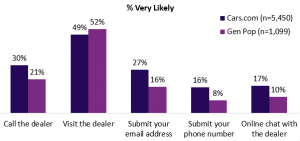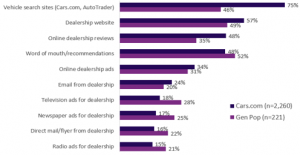Think of the last time you were asked to fill out a form online when researching or purchasing a product. Weren’t you hesitant? Collecting lead information like email addresses and phone numbers are still a great way to know a consumer is interested regardless of the product – albeit more important to the automotive industry. But, when you consider your own online behavior, you tend to shy away from providing personal information because you don’t want to be contacted or bothered unless you’re ready to engage.
Considering how you would behave in a given situation can be a good indicator of how others would behave in the same situation. Email and phone leads aren’t obsolete, but they are now only a fraction of how to gauge success with digital marketing.
Indeed, when we surveyed Cars.com visitors and non-Cars.com visitors who were in the market for a new vehicle and asked how likely they would be to engage with a dealer to get pricing or additional information, only 27 percent of Cars.com visitors and 16 percent of non-Cars.com visitors indicated they would submit an email lead. It was even fewer for submitting a phone lead (16 percent and 8 percent)¹.

Figure 1. Cars.com Consumer Metrics Study, October 2016
It’s important to note here the other ways in which consumers are choosing to engage with dealers. Figure 1 also indicates that both Cars.com and non-Cars.com visitors are more likely to visit a dealership lot to learn more about a vehicle than anything else.
So, we have to ask ourselves, is the lead submission form as important as we’ve previously thought when gauging digital marketing success or the success of vendor partners? We’ve looked at the data month over month and the answer is a growing ‘no, not like it used to be.’
A holistic approach is needed to understand how a modern consumer engages with a dealership to judge ad spend. Metrics like VDP views, map views, and driving directions along with geo-locating reporting together can build a story of engagement and interest by consumers in more detail than a simple email lead. Be sure to review all available data and reporting for similar metrics from all digital ad partners. Reviewing the wrong metrics and placing weight on them over more direct insight-driven metrics can lead to poor investment and review of spend.
This is why it’s important to create an online strategy that best utilizes third party vendors like Cars.com that help drive traffic to your lot – we influence consumers. In the same study where we asked how likely visitors are to submit lead information, we asked both Cars.com visitors and non-Cars.com visitors what most influenced their decision to select one dealer over another (Figure 2).

Figure 2. Cars.com Consumer Metrics Study, October 2016
Vehicle search sites have the most influence when it comes to choosing a dealer for visitors. Furthermore, by interacting with inventory, consumers are exposed to dealer information and can link to the dealer’s website.
This is the same pattern we’ve seen in Borrell Associates’ 2016 Auto Outlook study whereby they laid out future of advertising by medium for the automotive industry. Digital is taking the largest portion of the advertising pie because that’s where the majority of consumers go².
So, while email and phone leads can provide immediate measurement of success, they are not the most important way to gauge success for a digital ad spend or interest by consumers. Be sure to review what metrics and reporting are available to you against the inventory you have on the lot and online to create a strategy that will continue to drive sales and growth.
[1] Cars.com Consumer Metrics Study, October 2016
[2] 2016 Auto Outlook: The Thinning of the Media Pack, Borrell Associates, 2016



